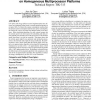Free Online Productivity Tools
i2Speak
i2Symbol
i2OCR
iTex2Img
iWeb2Print
iWeb2Shot
i2Type
iPdf2Split
iPdf2Merge
i2Bopomofo
i2Arabic
i2Style
i2Image
i2PDF
iLatex2Rtf
Sci2ools
SAC
2010
ACM
2010
ACM
Energy-efficient scheduling on homogeneous multiprocessor platforms
Low-power and energy-efficient system implementations have become very important design issues to extend operation duration or cut power bills. To balance the energy consumption resulting from the dynamic power consumption and the static power consumption, the concept of critical speed has been adopted widely in the literature. Most scheduling algorithms for such systems assume that the critical speed is the lowest speed for scheduling and then perform job/task procrastination to turn the processor(s) to the dormant mode when there is no job for execution. This paper shows that the critical speed might be too optimistic and turning the processor(s) to the dormant mode might be energy-inefficient. By allowing tasks to run at lower speeds than the critical speed, in this paper, a new approximation algorithm is developed for homogeneous
| Added | 19 Oct 2010 |
| Updated | 19 Oct 2010 |
| Type | Conference |
| Year | 2010 |
| Where | SAC |
| Authors | Jian-Jia Chen, Lothar Thiele |
Comments (0)

